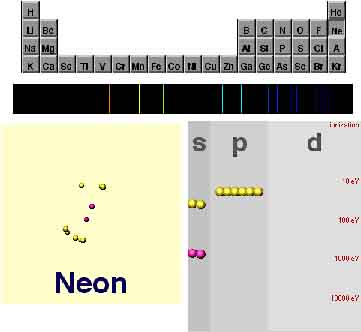Electron Configurations and the Periodic Table

 I understand the rules so far, but I still have a lot of questions. First of
all, I can see from the chart that the lowest row only has s electrons, but
the next row has electrons in both the s level and the p level, or whatever
you're supposed to call them...
I understand the rules so far, but I still have a lot of questions. First of
all, I can see from the chart that the lowest row only has s electrons, but
the next row has electrons in both the s level and the p level, or whatever
you're supposed to call them...
 "Sublevel" is fine; you can also speak of electrons' being in s or p "states."
You'll frequently hear these states called orbitals, especially in
chemistry. Of course, that term can be a little confusing--
"Sublevel" is fine; you can also speak of electrons' being in s or p "states."
You'll frequently hear these states called orbitals, especially in
chemistry. Of course, that term can be a little confusing--
 Yeah, yeah, I know--because electrons don't really orbit.
Yeah, yeah, I know--because electrons don't really orbit.
 Good, you've been paying attention. Incidentally, the s states in the first
primary level are called 1s orbitals, those in the second row 2s, and so
forth.
Good, you've been paying attention. Incidentally, the s states in the first
primary level are called 1s orbitals, those in the second row 2s, and so
forth.
Now, to return to your question: another rule you'll
have to remember is that the number of sublevels increases with each primary
energy level. The first row has just s orbitals, the second has s and p,
the third s, p, and d, and so forth.
 The way the periodic table is arranged is starting to
make sense to me now. The rows of the table match up with the primary energy
levels--that's why the first row only has two elements. In the second row,
lithium and beryllium are filling the two 2s spots; then there's a big space
because the next six elements are filling the 2p orbitals.
The way the periodic table is arranged is starting to
make sense to me now. The rows of the table match up with the primary energy
levels--that's why the first row only has two elements. In the second row,
lithium and beryllium are filling the two 2s spots; then there's a big space
because the next six elements are filling the 2p orbitals.

 That's exactly right. Now look at the third row; is it the way you'd expect
it to be?
That's exactly right. Now look at the third row; is it the way you'd expect
it to be?
 Hmm...sodium (Na) and magnesium (Mg) add
the two 3s electrons, and then the next six elements, up to argon (Ar), fill
the 3p orbitals. That's all fine, but why does the row end there? This row
should have a d sublevel, too, if you were telling the truth.
Hmm...sodium (Na) and magnesium (Mg) add
the two 3s electrons, and then the next six elements, up to argon (Ar), fill
the 3p orbitals. That's all fine, but why does the row end there? This row
should have a d sublevel, too, if you were telling the truth.
 I never lie--but I won't deny that there are more subtleties I haven't yet
revealed to you. Click on potassium (K), the first element in
the fourth row.
I never lie--but I won't deny that there are more subtleties I haven't yet
revealed to you. Click on potassium (K), the first element in
the fourth row.
 Hey! Now there's an electron in an 4s state, and still nothing in the 3d
orbitals. How do you explain that?
Hey! Now there's an electron in an 4s state, and still nothing in the 3d
orbitals. How do you explain that?






